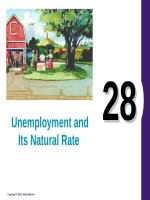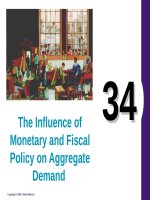Lecture Principles of economics - Chapter 6: Supply, demand, and government policies
Bạn đang xem bản rút gọn của tài liệu. Xem và tải ngay bản đầy đủ của tài liệu tại đây (439.98 KB, 37 trang )
Supply, Demand, and
Government Policies
Copyright © 2004 South-Western
6
Supply, Demand, and Government
Policies
• In a free, unregulated market system, market
forces establish equilibrium prices and
exchange quantities.
• While equilibrium conditions may be efficient,
it may be true that not everyone is satisfied.
• One of the roles of economists is to use their
theories to assist in the development of policies.
Copyright © 2004 South-Western/Thomson Learning
CONTROLS ON PRICES
• Are usually enacted when policymakers believe
the market price is unfair to buyers or sellers.
• Result in governmentcreated price ceilings and
floors.
Copyright © 2004 South-Western/Thomson Learning
CONTROLS ON PRICES
• Price Ceiling
• A legal maximum on the price at which a good can
be sold.
• Price Floor
• A legal minimum on the price at which a good can
be sold.
Copyright © 2004 South-Western/Thomson Learning
How Price Ceilings Affect Market Outcomes
• Two outcomes are possible when the
government imposes a price ceiling:
• The price ceiling is not binding if set above the
equilibrium price.
• The price ceiling is binding if set below the
equilibrium price, leading to a shortage.
Copyright © 2004 South-Western/Thomson Learning
Figure 1 A Market with a Price Ceiling
(a) A Price Ceiling That Is Not Binding
Price of
Ice-Cream
Cone
Supply
$4
Price
ceiling
3
Equilibrium
price
Demand
0
100
Equilibrium
quantity
Quantity of
Ice-Cream
Cones
Figure 1 A Market with a Price Ceiling
(b) A Price Ceiling That Is Binding
Price of
Ice-Cream
Cone
Supply
Equilibrium
price
$3
2
Price
ceiling
Shortage
Demand
0
75
125
Quantity
supplied
Quantity
demanded
Quantity of
Ice-Cream
Cones
Copyright©2003 Southwestern/Thomson Learning
How Price Ceilings Affect Market Outcomes
• Effects of Price Ceilings
• A binding price ceiling creates
• shortages because QD > QS.
• Example: Gasoline shortage of the 1970s
• nonprice rationing
• Examples: Long lines, discrimination by sellers
Copyright © 2004 South-Western/Thomson Learning
CASE STUDY: Lines at the Gas Pump
• In 1973, OPEC raised the price of crude
oil in world markets. Crude oil is the
major input in gasoline, so the higher oil
prices reduced the supply of gasoline.
• What was responsible for the long gas
lines?
• Economists blame government
regulations that limited the price oil
companies could charge for
gasoline.
Copyright © 2004 South-Western/Thomson Learning
Figure 2 The Market for Gasoline with a Price Ceiling
(a) The Price Ceiling on Gasoline Is Not Binding
Price of
Gasoline
Supply,S1
1. Initially,
the price
ceiling
is not
binding . . .
Price ceiling
P1
Demand
0
Q1
Quantity of
Gasoline
Copyright©2003 Southwestern/Thomson Learning
Figure 2 The Market for Gasoline with a Price Ceiling
(b) The Price Ceiling on Gasoline Is Binding
Price of
Gasoline
S2
2. . . . but when
supply falls . . .
S1
P2
Price ceiling
3. . . . the price
ceiling becomes
binding . . .
P1
4. . . .
resulting
in a
shortage.
Demand
0
QS
QD Q1
Quantity of
Gasoline
Copyright©2003 Southwestern/Thomson Learning
CASE STUDY: Rent Control in the Short Run
and Long Run
• Rent controls are ceilings placed on the rents
that landlords may charge their tenants.
• The goal of rent control policy is to help the
poor by making housing more affordable.
• One economist called rent control “the best way
to destroy a city, other than bombing.”
Copyright © 2004 South-Western/Thomson Learning
Figure 3 Rent Control in the Short Run and in the Long Run
(a) Rent Control in the Short Run
(supply and demand are inelastic)
Rental
Price of
Apartment
Supply
Controlled rent
Shortage
Demand
0
Quantity of
Apartments
Copyright©2003 Southwestern/Thomson Learning
Figure 3 Rent Control in the Short Run and in the Long Run
(b) Rent Control in the Long Run
(supply and demand are elastic)
Rental
Price of
Apartment
Supply
Controlled rent
Shortage
0
Demand
Quantity of
Apartments
Copyright©2003 Southwestern/Thomson Learning
How Price Floors Affect Market Outcomes
• When the government imposes a price floor,
two outcomes are possible.
• The price floor is not binding if set below the
equilibrium price.
• The price floor is binding if set above the
equilibrium price, leading to a surplus.
Copyright © 2004 South-Western/Thomson Learning
Figure 4 A Market with a Price Floor
(a) A Price Floor That Is Not Binding
Price of
Ice-Cream
Cone
Supply
Equilibrium
price
$3
Price
floor
2
Demand
0
100
Equilibrium
quantity
Quantity of
Ice-Cream
Cones
Copyright©2003 Southwestern/Thomson Learning
Figure 4 A Market with a Price Floor
(b) A Price Floor That Is Binding
Price of
Ice-Cream
Cone
Supply
Surplus
$4
Price
floor
3
Equilibrium
price
Demand
0
Quantity of
Quantity Quantity Ice-Cream
Cones
demanded supplied
80
120
Copyright©2003 Southwestern/Thomson Learning
How Price Floors Affect Market Outcomes
• A price floor prevents supply and demand from
moving toward the equilibrium price and quantity.
• When the market price hits the floor, it can fall no
further, and the market price equals the floor price.
Copyright © 2004 South-Western/Thomson Learning
How Price Floors Affect Market Outcomes
• A binding price floor causes . . .
• a surplus because QS > QD.
• nonprice rationing is an alternative mechanism for
rationing the good, using discrimination criteria.
• Examples: The minimum wage, agricultural price
supports
Copyright © 2004 South-Western/Thomson Learning
The Minimum Wage
• An important example of a price floor is the
minimum wage. Minimum wage laws dictate
the lowest price possible for labor that any
employer may pay.
Copyright © 2004 South-Western/Thomson Learning
Figure 5 How the Minimum Wage Affects the Labor Market
Wage
Labor
Supply
Equilibrium
wage
Labor
demand
0
Equilibrium
employment
Quantity of
Labor
Copyright©2003 Southwestern/Thomson Learning
Figure 5 How the Minimum Wage Affects the Labor Market
Wage
Labor surplus
(unemployment)
Labor
Supply
Minimum
wage
Labor
demand
0
Quantity
demanded
Quantity
supplied
Quantity of
Labor
Copyright©2003 Southwestern/Thomson Learning
TAXES
• Governments levy taxes to raise revenue for
public projects.
Copyright © 2004 South-Western/Thomson Learning
How Taxes on Buyers (and Sellers) Affect
Market Outcomes
• Taxes discourage market activity.
• When a good is taxed, the
quantity sold is smaller.
• Buyers and sellers share
the tax burden.
Copyright © 2004 South-Western/Thomson Learning
Elasticity and Tax Incidence
• Tax incidence is the manner in which the
burden of a tax is shared among participants in
a market.
Copyright © 2004 South-Western/Thomson Learning









